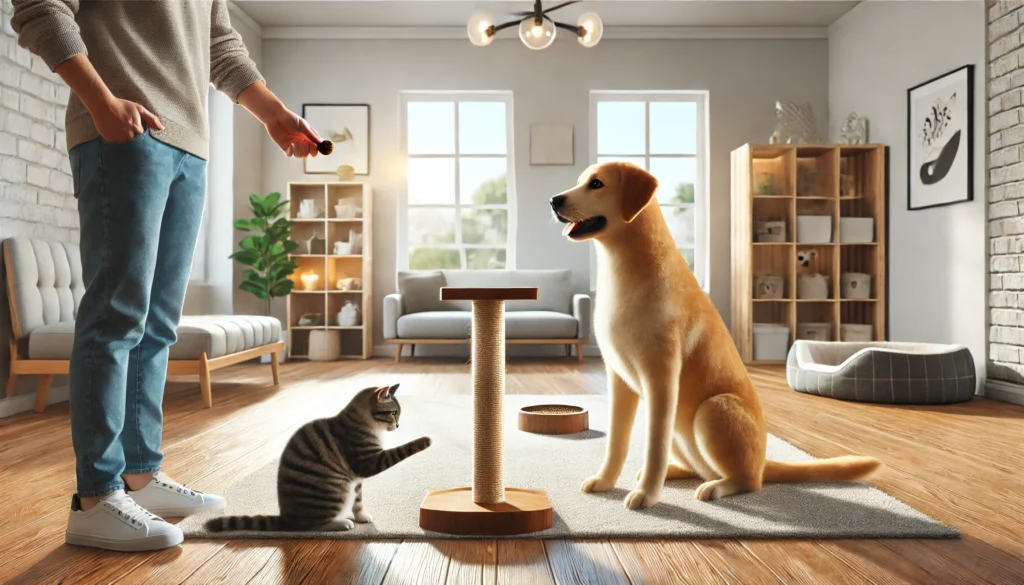Helping your dog or cat behave well indoors is not about control — it’s about communication, consistency, and environment. When you understand how to guide your pet gently and positively, you create a space where they can thrive with trust and respect.
These everyday strategies will help you encourage good behavior naturally at home.
Set Clear and Consistent Boundaries
Pets need to know what is allowed and what isn’t — and consistency is key.
- Choose house rules and stick to them. For example: no pets on the table, or no jumping on guests.
- Everyone in the household must follow the same rules with the pet.
- Use simple, repeated commands like “down,” “off,” or “no.”
When expectations are clear, pets feel more secure and behave better.
Use Positive Reinforcement
Rewarding good behavior is far more effective than punishing bad behavior.
- Use treats, affection, and praise immediately after the desired action.
- Catch your pet doing something right — and celebrate it.
- Reinforce behaviors you want repeated, like using the litter box or waiting at the door.
This builds trust and encourages your pet to choose the right behavior on their own.
Redirect Instead of Scolding
If your pet misbehaves, it’s more helpful to redirect than to punish.
- Say “no” in a calm but firm voice, then guide them toward a better option.
- If a dog is chewing furniture, replace it with a chew toy.
- If a cat scratches the couch, lead them to a scratching post.
This teaches what’s appropriate without fear or confusion.
Make the Environment Work for You
Sometimes behavior issues stem from boredom or lack of structure.
- Give your pet enough stimulation (toys, play, puzzles).
- Ensure they have their own space to relax undisturbed.
- Remove tempting items (like shoes or wires) from reach.
A well-prepared space reduces frustration and encourages calm behavior.
Establish a Daily Routine
Pets, like people, thrive on routine.
- Feed, play, and rest at the same times each day.
- Let dogs outside for bathroom breaks regularly.
- Clean litter boxes and feeding areas consistently.
Routines help pets know what to expect, which reduces anxiety and outbursts.
Reinforce Calmness
Reward your pet when they’re calm — not just when they’re active.
- Give a treat when your dog is lying quietly.
- Pet your cat when they’re relaxed and not demanding attention.
- Avoid accidentally rewarding pushy or hyperactive behavior.
This teaches them that calmness earns rewards.
Stay Patient and Consistent
Behavior change takes time — especially with rescues or older pets.
- Avoid yelling or using physical punishment.
- Use the same tone, words, and responses every time.
- Stay calm during setbacks, and reinforce the behavior you want instead.
Consistency builds trust, and trust leads to better behavior.
Teach Basic Commands
Training simple commands helps pets feel connected and gives them direction.
- Start with “sit,” “stay,” or “come” for dogs.
- Try “no,” “down,” or even “high five” for cats.
- Practice a few minutes daily, using positive reinforcement.
Training provides structure and encourages good habits.
Socialize Safely
For pets who live with others (pets or people), positive social behavior matters.
- Supervise interactions and guide behavior gently.
- Reward good interactions — like sharing space or greeting calmly.
- Use short, positive experiences to build confidence.
A well-socialized pet is a happier and better-behaved one.
Your home is your pet’s whole world — and how they behave reflects how they feel in it. By encouraging positive actions with love, structure, and support, you’re building not just a well-behaved pet, but a strong and lasting bond.






